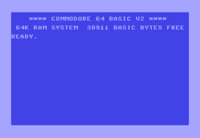Current standards
Televisionsedit
Televisions are of the following resolutions:
- Standard-definition television (SDTV):
- 480i (NTSC-compatible digital standard employing two interlaced fields of 243 lines each)
- 576i (PAL-compatible digital standard employing two interlaced fields of 288 lines each)
- Enhanced-definition television (EDTV):
- 480p (720 × 480 progressive scan)
- 576p (720 × 576 progressive scan)
- High-definition television (HDTV):
- 720p (1280 × 720 progressive scan)
- 1080i (1920 × 1080 split into two interlaced fields of 540 lines)
- 1080p (1920 × 1080 progressive scan)
- Ultra-high-definition television (UHDTV):
- 4K UHD (3840 × 2160 progressive scan)
- 8K UHD (7680 × 4320 progressive scan)
Computer monitorsedit
Computer monitors have traditionally possessed higher resolutions than most televisions.
2000sedit
In 2002, 1024 × 768 eXtended Graphics Array was the most common display resolution. Many web sites and multimedia products were re-designed from the previous 800 × 600 format to the layouts optimized for 1024 × 768.
The availability of inexpensive LCD monitors made the 5:4 aspect ratio resolution of 1280 × 1024 more popular for desktop usage during the first decade of the 21st century. Many computer users including CAD users, graphic artists and video game players ran their computers at 1600 × 1200 resolution (UXGA) or higher such as 2048 × 1536 QXGA if they had the necessary equipment. Other available resolutions included oversize aspects like 1400 × 1050 SXGA+ and wide aspects like 1280 × 800 WXGA, 1440 × 900 WXGA+, 1680 × 1050 WSXGA+, and 1920 × 1200 WUXGA; monitors built to the 720p and 1080p standard were also not unusual among home media and video game players, due to the perfect screen compatibility with movie and video game releases. A new more-than-HD resolution of 2560 × 1600 WQXGA was released in 30-inch LCD monitors in 2007.
2010sedit
As of March 2012update, 1366 × 768 was the most common display resolution.
In 2010, 27-inch LCD monitors with the 2560 × 1440-pixel resolution were released by multiple manufacturers including Apple, and in 2012, Apple introduced a 2880 × 1800 display on the MacBook Pro. Panels for professional environments, such as medical use and air traffic control, support resolutions of up to 4096 × 2160 pixels.
Common display resolutionsedit
The following table lists the usage share of display resolutions from two sources, as of June 2020. The numbers are not representative of computer users in general.
| Standard | Aspect ratio | Width (px) | Height (px) | Megapixels | Steam (%) | StatCounter (%) |
|---|---|---|---|---|---|---|
| nHD | 16:9 | 640 | 360 | 0.230 | N/A | 0.47 |
| SVGA | 4:3 | 800 | 600 | 0.480 | N/A | 0.76 |
| XGA | 4:3 | 1024 | 768 | 0.786 | 0.38 | 2.78 |
| WXGA | 16:9 | 1280 | 720 | 0.922 | 0.36 | 4.82 |
| WXGA | 16:10 | 1280 | 800 | 1.024 | 0.61 | 3.08 |
| SXGA | 5:4 | 1280 | 1024 | 1.311 | 1.24 | 2.47 |
| HD | ≈16:9 | 1360 | 768 | 1.044 | 1.55 | 1.38 |
| HD | ≈16:9 | 1366 | 768 | 1.049 | 10.22 | 23.26 |
| WXGA+ | 16:10 | 1440 | 900 | 1.296 | 3.12 | 6.98 |
| N/A | 16:9 | 1536 | 864 | 1.327 | N/A | 8.53 |
| HD+ | 16:9 | 1600 | 900 | 1.440 | 2.59 | 4.14 |
| WSXGA+ | 16:10 | 1680 | 1050 | 1.764 | 1.97 | 2.23 |
| FHD | 16:9 | 1920 | 1080 | 2.074 | 64.81 | 20.41 |
| WUXGA | 16:10 | 1920 | 1200 | 2.304 | 0.81 | 0.93 |
| QWXGA | 16:9 | 2048 | 1152 | 2.359 | N/A | 0.51 |
| N/A | ≈21:9 | 2560 | 1080 | 2.765 | 1.13 | N/A |
| QHD | 16:9 | 2560 | 1440 | 3.686 | 6.23 | 2.15 |
| N/A | ≈21:9 | 3440 | 1440 | 4.954 | 0.87 | N/A |
| 4K UHD | 16:9 | 3840 | 2160 | 8.294 | 2.12 | N/A |
| Other | 2.00 | 15.09 |
When a computer display resolution is set higher than the physical screen resolution (native resolution), some video drivers make the virtual screen scrollable over the physical screen thus realizing a two dimensional virtual desktop with its viewport. Most LCD manufacturers do make note of the panel's native resolution as working in a non-native resolution on LCDs will result in a poorer image, due to dropping of pixels to make the image fit (when using DVI) or insufficient sampling of the analog signal (when using VGA connector). Few CRT manufacturers will quote the true native resolution, because CRTs are analog in nature and can vary their display from as low as 320 × 200 (emulation of older computers or game consoles) to as high as the internal board will allow, or the image becomes too detailed for the vacuum tube to recreate (i.e., analog blur). Thus, CRTs provide a variability in resolution that fixed resolution LCDs cannot provide.
In recent years the 16:9 aspect ratio has become more common in notebook displays. 1366 × 768 (HD) has become popular for most notebook sizes, while 1600 × 900 (HD+) and 1920 × 1080 (FHD) are available for larger notebooks.
As far as digital cinematography is concerned, video resolution standards depend first on the frames' aspect ratio in the film stock (which is usually scanned for digital intermediate post-production) and then on the actual points' count. Although there is not a unique set of standardized sizes, it is commonplace within the motion picture industry to refer to "nK" image "quality", where n is a (small, usually even) integer number which translates into a set of actual resolutions, depending on the film format. As a reference consider that, for a 4:3 (around 1.33:1) aspect ratio which a film frame (no matter what is its format) is expected to horizontally fit in, n is the multiplier of 1024 such that the horizontal resolution is exactly 1024•n points.citation needed For example, 2K reference resolution is 2048 × 1536 pixels, whereas 4K reference resolution is 4096 × 3072 pixels. Nevertheless, 2K may also refer to resolutions like 2048 × 1556 (full-aperture), 2048 × 1152 (HDTV, 16:9 aspect ratio) or 2048 × 872 pixels (Cinemascope, 2.35:1 aspect ratio). It is also worth noting that while a frame resolution may be, for example, 3:2 (720 × 480 NTSC), that is not what you will see on-screen (i.e. 4:3 or 16:9 depending on the orientation of the rectangular pixels).
Evolution of standardsedit
Many personal computers introduced in the late 1970s and the 1980s were designed to use television receivers as their display devices, making the resolutions dependent on the television standards in use, including PAL and NTSC. Picture sizes were usually limited to ensure the visibility of all the pixels in the major television standards and the broad range of television sets with varying amounts of over scan. The actual drawable picture area was, therefore, somewhat smaller than the whole screen, and was usually surrounded by a static-colored border (see image to right). Also, the interlace scanning was usually omitted in order to provide more stability to the picture, effectively halving the vertical resolution in progress. 160 × 200, 320 × 200 and 640 × 200 on NTSC were relatively common resolutions in the era (224, 240 or 256 scanlines were also common). In the IBM PC world, these resolutions came to be used by 16-color EGA video cards.
One of the drawbacks of using a classic television is that the computer display resolution is higher than the television could decode. Chroma resolution for NTSC/PAL televisions are bandwidth-limited to a maximum 1.5 megahertz, or approximately 160 pixels wide, which led to blurring of the color for 320- or 640-wide signals, and made text difficult to read (see second image to right). Many users upgraded to higher-quality televisions with S-Video or RGBI inputs that helped eliminate chroma blur and produce more legible displays. The earliest, lowest cost solution to the chroma problem was offered in the Atari 2600 Video Computer System and the Apple II+, both of which offered the option to disable the color and view a legacy black-and-white signal. On the Commodore 64, the GEOS mirrored the Mac OS method of using black-and-white to improve readability.
The 640 × 400i resolution (720 × 480i with borders disabled) was first introduced by home computers such as the Commodore Amiga and, later, Atari Falcon. These computers used interlace to boost the maximum vertical resolution. These modes were only suited to graphics or gaming, as the flickering interlace made reading text in word processor, database, or spreadsheet software difficult. (Modern game consoles solve this problem by pre-filtering the 480i video to a lower resolution. For example, Final Fantasy XII suffers from flicker when the filter is turned off, but stabilizes once filtering is restored. The computers of the 1980s lacked sufficient power to run similar filtering software.)
The advantage of a 720 × 480i overscanned computer was an easy interface with interlaced TV production, leading to the development of Newtek's Video Toaster. This device allowed Amigas to be used for CGI creation in various news departments (example: weather overlays), drama programs such as NBC's seaQuest, The WB's Babylon 5, and early computer-generated animation by Disney for The Little Mermaid, Beauty and the Beast, and Aladdin.
In the PC world, the IBM PS/2 VGA (multi-color) on-board graphics chips used a non-interlaced (progressive) 640 × 480 × 16 color resolution that was easier to read and thus more useful for office work. It was the standard resolution from 1990 to around 1996.citation needed The standard resolution was 800 × 600 until around 2000. Microsoft Windows XP, released in 2001, was designed to run at 800 × 600 minimum, although it is possible to select the original 640 × 480 in the Advanced Settings window.
Programs designed to mimic older hardware such as Atari, Sega, or Nintendo game consoles (emulators) when attached to multiscan CRTs, routinely use much lower resolutions, such as 160 × 200 or 320 × 400 for greater authenticity, though other emulators have taken advantage of pixelation recognition on circle, square, triangle and other geometric features on a lesser resolution for a more scaled vector rendering. Some emulators, at higher resolutions, can even mimic the aperture grille and shadow masks of CRT monitors.

In this image of a Commodore 64 startup screen, the overscan region (the lighter-coloured border) would have been barely visible when shown on a normal television.

A 640 × 200 display as produced by a monitor (left) and television

16-color (top) and 256-color (bottom) progressive images from a 1980s VGA card. Dithering is used to overcome color limitations.
Commonly usededit
The list of common resolutions article lists the most commonly used display resolutions for computer graphics, television, films, and video conferencing.



Comments
Post a Comment